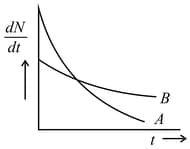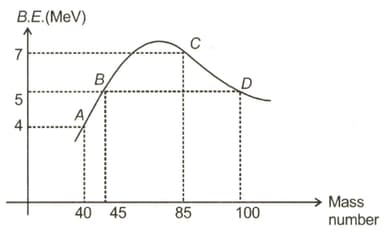The probability of disintegration per second of a nucleus in a given radio-active sample

Important Questions on Nuclei
The variation of decay rate of two radioactive samples A and B with time is shown in figure. Which of the following statements are true?

A parent nuclide (decay constant ) has number of atoms at time Nuclide decays to nuclide which further decays with decay constant [number of atoms of at a given time, number of atoms of at a given time]
| List-I | List-II | ||
| (I) | at time | (P) | |
| (II) | at time | (Q) | |
| (III) | Probability that a particular atom of survives till time | (R) | |
| (IV) | The ratio of numbers of atoms of and at time | (S) | |
| (T) | |||
| (U) | |||
If then the correct match is
A parent nuclide (decay constant ) has number of atoms at time Nuclide decays to nuclide which further decays with decay constant [number of atoms of at a given time, number of atoms of at a given time]
| List-I | List-II | ||
| (I) | at time | (P) | |
| (II) | at time | (Q) | |
| (III) | Probability that a particular atom of survives till time | (R) | |
| (IV) | The ratio of numbers of atoms of and at time | (S) | |
| (T) | |||
| (U) | |||
If then the correct match is
Binding energy per nucleon versus mass number curve for nuclei is shown in figure. and are four nuclei indicated on the curve. The value of following nuclear reaction is Find the value of

Average power radiated by the star is If duetron supply of the star is exhausted in a time
then value of is
Given
